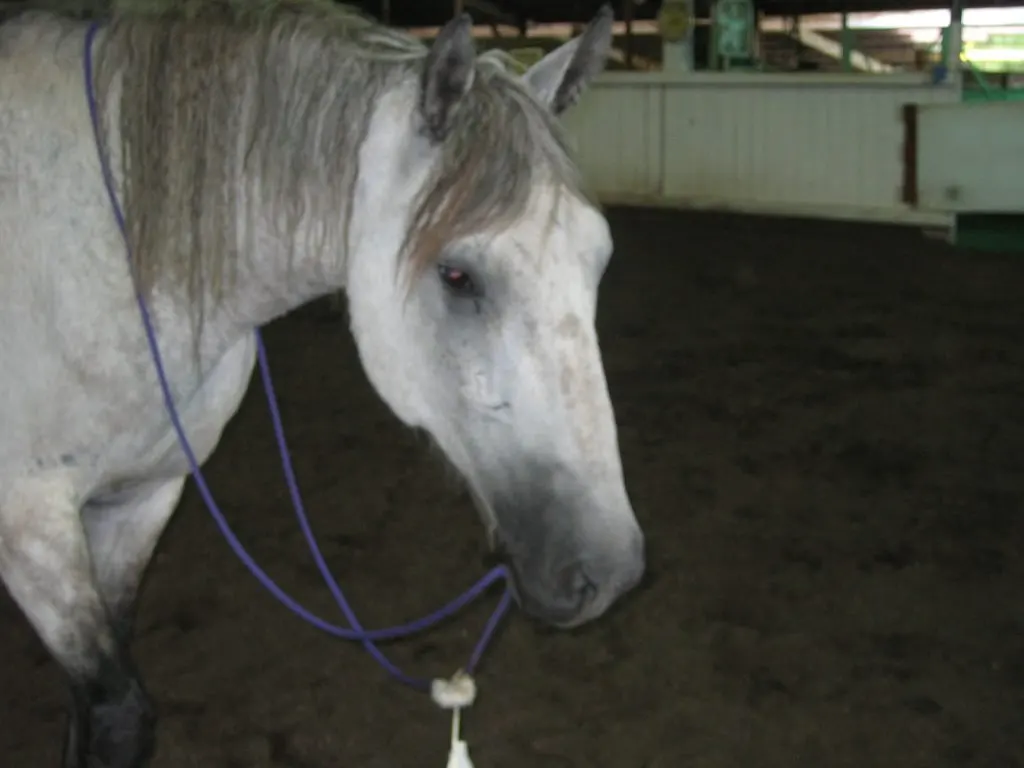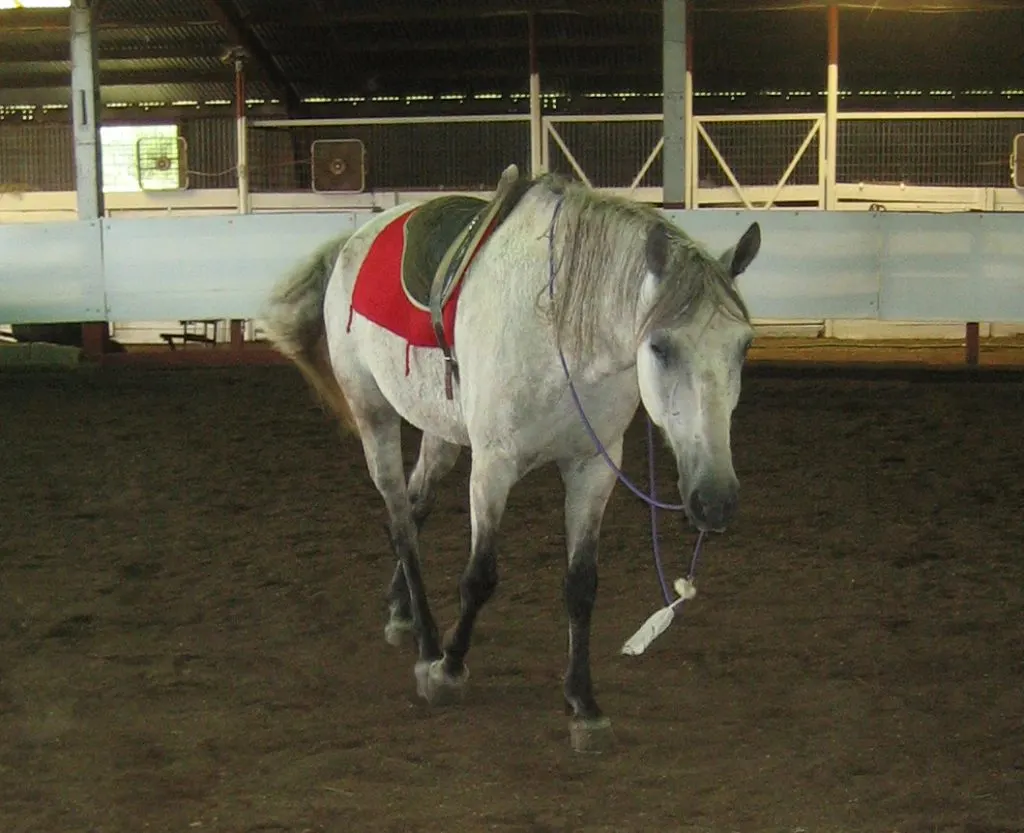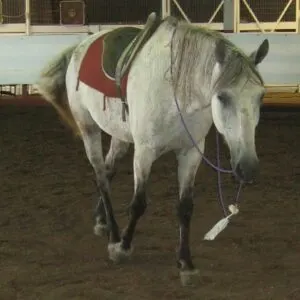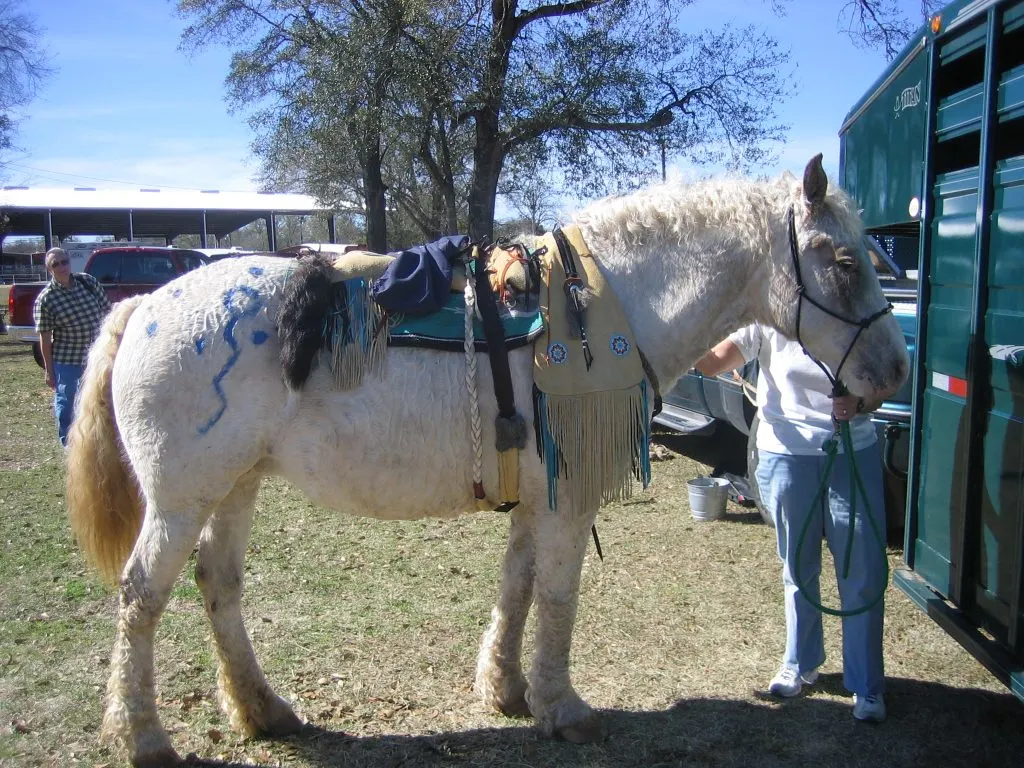A war bridle is a minimalist horse bridle made from a single continuous piece of rope. There are several variants of a war bridle, but the most common is a loop of rope that encircles the horse’s lower jaw. The loop of rope passes through the horse’s mouth and rests in the mouth like a typical bit.
How a War Bridle Works:
The war bridle stays in place in the mouth thanks to tension and basic horse anatomy.
- Anatomy – The “bit” rests in the same position where a traditional bit sits.
- Tension – A simple loop around the horse’s lower jaw – which is secured snugly but not tight- keeps the horse from spitting the war bridle mouthpiece out.
Simple reins connect to this loop and allow the rider to control their horse without the use of a bridle, headstall, or traditional bit.
History
Traditionally, the reins on this type of bridle were very long. So long, in fact, that a Native American rider could loop them partially over a shoulder!
War bridles were, as you might guess from the name, used by some tribes during battle. The extra long reins of the war bridle meant that a rider could have both hands free to shoot a bow and reload.

When to Use a War Bridle
Technically, because the War Bridle does pass through the horse’s mouth, it is not a bitless bridle. However, this piece of tack (called the “‘Indian’ War Bridle” by generations past) may be an excellent option for some well-trained horses.
This minimalist bridle can be a great option for horses that, due to physical issues around the ears, eyes, or face, can’t wear a traditional bridle, a bitless bridle, or a loping hackamore. Growths, hair loss, or skin issues around the eyes or ears are valid reasons a horse may not be able to wear a bridle with a headstall.
War Bridles are for horses with plenty of training. Certainly, history would show that many horses have been broken to this style of bridle without previous training. But for the safety and comfort of both horse and rider, it’s important to move more slowly. Before transitioning to a war bridle you’ll want to first have a horse that responds well to gentle rein cues and turns off pressure from your legs.

A war bridle is not for casual experimentation, for green horses or beginner riders. If you are a rider who halts your horse and turns using your reins, a war bridle is not right for you yet.
If you or your horse are “green”, the last thing you want is to tie a knot around a very sensitive part of a horse’s body and let that be your only method of control.
Reasons to Use a War Bridle
Although this way of tacking up isn’t for everyone, there are some good reasons to use try using a war bridle, including:
- Personal Challenge. Not every horse and rider can thrive in a war bridle. Trying out this piece of tack in a safe way can be a low risk personal challenge.
- Novelty. Both horses and humans thrive when there’s a little novelty in our training routine. (Who wants to ride in an arena every day? That’s why we’ve come up with so many fun games on horseback)
- Gaining insight into how you communicate with your horse. Even if a war bridle isn’t your new favorite piece of tack, a few rides in this minimalist bridle can help you understand (and correct) your overreliance on a traditional bit and reins.
- Riding a horse with head or neck scars, trauma, or sensitivities. Some incredible horses have been retired or sold simply due to ear sensitivity, painful scars, or even conformational issues with bridles. By eliminating a headstall, a war bridle offers an alternative for these horses.
- Cultural connection. For those of us with an ancestral connection to Indigenous Americans, war bridles may be a route to self-exploration. Trying a war bridle can be a way to explore an embodied connection with our heritage.
A war bridle can be a fun way to challenge yourself and your well-trained horse. Before trying out a war bridle, try riding your horse with dropped reins. When you can reliably turn, slow, and stop your horse using only your seat and legs, give it a shot!
How to Introduce Your Horse to a War Bridle

How to Use a War Bridle
Get Familiar With the Tack
First, get familiar with the war bridle. Learn about how it works, and how to put it on your horse’s head. Ideally, you may wish to ride a friend or trainer’s horse that is already trained to ride wearing a war bridle. Once you are comfortable with the war bridle, it’s time to introduce it to your horse.
Introduce Your Horse to the Bridle
The rope mouthpiece will feel unfamiliar to a horse. It’s best to introduce them gently. Begin introducing the war bridle to your horse by placing the rawhide-covered rope mouthpiece of the bridle into your horse’s mouth while they are tied in a calm space. Let your horse get used to the sensation of the mouthpiece around its jaw.
Round Pen Your Horse While Wearing a War Bridle
Once your horse is comfortable with the rope mouthpiece, lead your horse – using a halter – into a safe area such as a round pen. While unmounted, get your horse used to moving in the war bridle. Using a lunge line attached to the halter only, lunge your horse at a walk, trot, and canter. This gives them an opportunity to get used to the war bridle before a rider mounts.
Evaluate
If your horse has adapted to the war bridle without acting uncomfortable or behaving erratically, that’s good! If you feel like your horse is ready, mount up.
Mount and Ride
Keep the halter and lead rope attached. Have a handler on the ground lead your horse until you are sure your horse can stop and turn reliably based on cues from your body and the war bridle.
Only after you have confirmed a well-trained whoa and obedient turning should you remove the halter and proceed to ride in this simple minimalist bridle.
Get Professional Support
If these steps for using a war bridle are confusing or your horse’s behavior is concerning, stop and consult a professional horse trainer.
How I Learned to Ride With a War Bridle
In the early 2000’s I had the opportunity to ride in a clinic instructing curious riders on the riding styles of a particular tribe of indigenous Americans. This purple war bridle was my take-home gift, as a thank-you for being the demo rider.
Mine has an elk hide wrapped mouthpiece. Simple, uncoated rope could make for a very harsh correction in a horse’s mouth, but wrapping it in hide makes the mouthpiece softer, less abrasive, and wider. In the world of horse bits, generally when a bit is wider, it’s gentler. Narrower bits provide a sharper correction to a horse.
The Native American war bridle takes a piece of rope and runs it through the mouth where the bit would sit, ties around the jaw to stay in place, then runs back as reins. I don’t think any company is currently producing these, but if you searched and checked with local resources for indigenous horse trainers you could probably find a craftsman making them.
This headstall-less bridle makes it look as though the horse is wearing no bridle at all. It was the bridle native people would use for war or hunting, where sometimes they needed their horse to move more precisely than their seat-cues could communicate when their upper bodies were engaged in hunting or another active activity.
Native riders were generally excellent horseback riders and rode with their whole body. This type of riding meant guiding their horse totally off their legs and seat. If they were in a dangerous spot, they would pick up a rein and cue the horse to move sharply.

One Unique Native American Saddle Type
I’m sure there are many variations of saddles used by indigenous Americans, but one fascinating thing I experienced as a rider in the clinic was the “saddle” I was allowed to use: It was similar to a bareback pad, but instead of stirrups there was a rawhide rope encircling the horse’s barrel like a very loose girth.
I learned this “loose girth” would allow me to tuck my knees under the rope and use the rope and my body to hold myself on the horse. I was instructed to slide my knees (but not my feet- in case I fell) underneath the rope. As I rode, I found that if I needed more security in the saddle, I could spread my knees, and the rope would tighten and pull my seat down into the saddle. Surprisingly, it was very natural and arguably more comfortable than stirrups!

Photos in this post feature my Bashkir Curly gelding in a Native American war bridle that was gifted to us by a fellow rider who is Native American. This horse, trained with classical dressage methods, happily works in a double bridle, war bridle, or no bridle at all! Although I typically ride dressage, I’ve enjoyed learning about Native American tack and riding styles as a way to connect with my own maternal great-grandmother, who was born into a Great Plains tribe, but whose history and even tribe affiliation were obliterated along with her entire immediate family in America’s violence against indigenous people.
Can you use a war bridle with an English-trained horse?
Yes, the war bridle can be used on horses that have been ridden or trained exclusively English or Western. Despite popular belief, the differences between English and Western riding fundamentals are minor- especially from a horse’s perspective.
As long as your horse is trained to respond to cues from your seat and legs, horses may do well when ridden with a war bridle. When introducing any new tack to your horse, always introduce the item gradually, and give your horse a chance to get used to it without force, intimidation, or excess pressure.


Larry King
Saturday 7th of September 2019
Is it legal to ride a war bridle in aqha classes.
Amanda Argenbright
Saturday 23rd of June 2018
I would like to see the "saddle" used in demo in action so I can be as authentic in costume as possible with my mustang.
Tatum
Tuesday 26th of June 2018
Thanks for your comment! I can definitely see where it would be fun to create a costume for your Mustang that represents the breed history, but as a European-American, I'm not comfortable posting images of Native American saddlery for the purpose of costuming. If you have questions about costume you could try reaching out to the Tribal Nations known for that type of saddlery and asking about resources available for learning about their horsemanship, saddlery, and permission for creating replicas for your Mustang. I believe the saddle I described was used by a member of the Cherokee Nation.